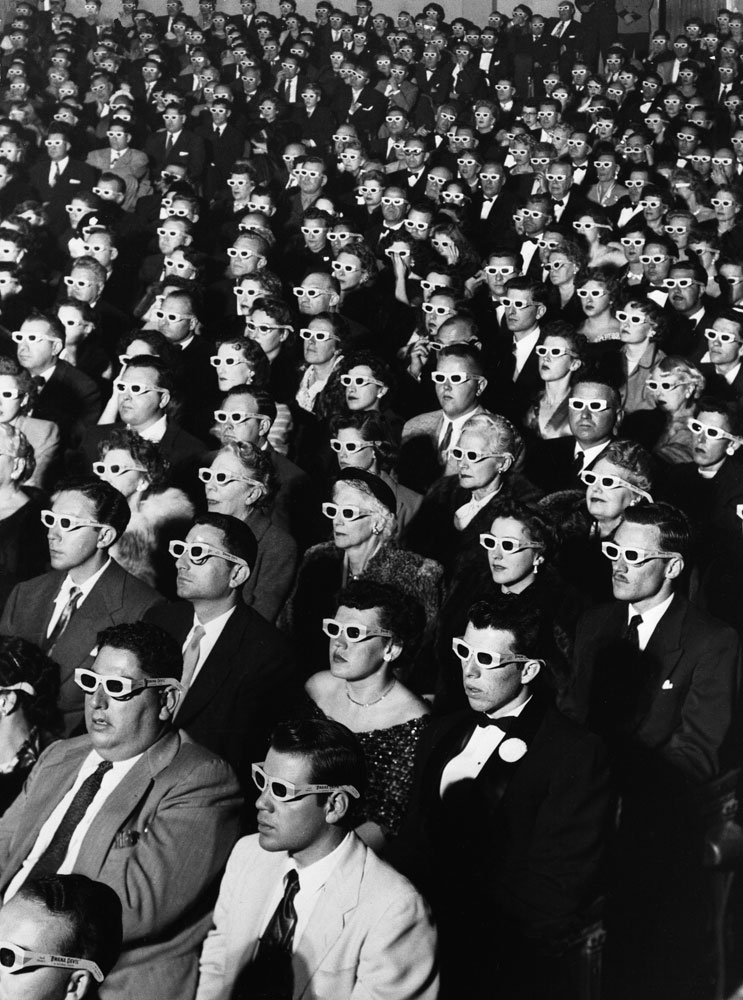
In the early 1950s, when Milton Gunzburg, a scriptwriter at MGM, and his brother Julian, a Beverly Hills ophthalmologist, developed a process that would allow moviegoers to watch the dominant entertainment medium of the age in what came to be called “3-D,” they figured Hollywood studios would leap at the chance to take advantage of their brainchild.
But movie studios, broadly speaking, are notoriously cautious creatures, and only one person — the remarkable and now largely forgotten screenwriter, director, producer and radio pioneer Arch Oboler — showed enough interest in the Gunzburg’s “Natural Vision” process to actually use the technology in one of his productions. When his 1952 movie, Bwana Devil, was released (a based-on-true-events story about man-eating lions written, produced and directed by Oboler himself), Natural Vision was a huge part of the promotional campaign.
“The World’s First Feature Length Motion Picture in Natural Vision 3-Dimension,” Bwana Devil posters proclaimed. The movie’s tagline, meanwhile, offered the striking, near-poetic promise of “A LION in your lap! A LOVER in your arms!”
The striking J.R. Eyerman photo above — made during the Nov. 26, 1952, opening night screening of Bwana Devil at Hollywood’s Paramount Theater — has been reproduced so many times and is now so famous in its own right that it’s difficult, today, to appreciate just how strange and enticing the idea of three-dimensional viewing really was.
[MORE: See the gallery, “The Best of LIFE: 37 Years in Pictures”]
As a seemingly surefire draw to get people in the seats, 3-D had been around since well before Oboler and the Gunzburgs unleashed it on the Paramount crowd. Stereoscopic pictures — both the still and the moving variety — had enthralled viewers for decades; but no one had taken the concept as far as Arch Oboler, producing and distributing a full-length 3-D feature film, in color, for a mass audience.
As visionary as Oboler’s effort might have been, the movie with which he introduced 3-D motion pictures to the world, while profitable, was destined to be remembered for agitating a good number of the men and women in the audience, rather than entertaining them.
In its December 15, 1952, issue — the issue in which Eyerman’s famous photograph of the Paramount audience first appeared — LIFE magazine summed up the evening thus:
These megalopic creatures are the first paying audience for the latest cinematic novelty, Natural Vision. This process gets a three-dimensional effect by using two projectors with Polaroid filters and giving the spectators Polaroid spectacles to wear. The movie at the premiere, called Bwana Devil, did achieve some striking three-dimensional sequences. But members of the audience reported that the glasses were uncomfortable, the film itself — dealing with two scholarly looking lions who ate up quantities of humans in Africa — was dull, and it was generally agreed that the audience itself looked more startling than anything on the screen.
Dull or not, the movie — produced for an at-the-time stratospheric $400,000 — made more than $2.5 million at the box office to become one of the biggest hits of 1953.
Today, after seeing the craze for three-dimensional films wax and wane numerous times over the intervening decades, moviegoers find themselves in the midst of something like a 3-D Golden Age. James Cameron’s eye-popping 2009 sci-fi fable, Avatar (the highest-grossing movie of all time), was the 3-D success story that really re-opened the rusty floodgates. Now, four years later, it feels that every other title, new or old, has XpanD 3D, RealD 3D, Dolby 3D or some other trademarked, extra-dimensional appellation appended to it.
[MORE: Read Richard Corliss’ reviews of Avatar and Life of Pi]
Sometimes the treatment sounds like a great idea. (Monsters, Inc. re-released in 3-D? We’re in.) Occasionally, however, moviegoers are left scratching their heads, wondering exactly what compelled a studio or director to make that utterly unnecessary call. (Did Ridley Scott really feel that fans would stay away from Prometheus if he made it in plain old 2-D? Whatever the reasoning, that third dimensionality added nothing to the movie’s trippy power.)
In the grand scheme of things, six decades is nothing: it’s an eye blink. In pop-culture terms, though, it’s an eternity. In Hollywood, eons pass between award seasons. Strangely enough, it’s that very transience that makes Eyerman’s picture from the Paramount in 1952, with its rapt audience, all the more engaging.
In the years since Bwana Devil enticed (and then let down) thousands of movie fans, the technology of the medium has changed, the fashions worn to the theater have changed — everything about going to the movies has changed, except for one vital, enduring quality that has always defined the experience: a collective suspension of disbelief that is indistinguishable from wonder.
And that’s something worth embracing, in any dimension.
Ben Cosgrove is the Editor of LIFE.com

More Must-Reads from TIME
- Donald Trump Is TIME's 2024 Person of the Year
- Why We Chose Trump as Person of the Year
- Is Intermittent Fasting Good or Bad for You?
- The 100 Must-Read Books of 2024
- The 20 Best Christmas TV Episodes
- Column: If Optimism Feels Ridiculous Now, Try Hope
- The Future of Climate Action Is Trade Policy
- Merle Bombardieri Is Helping People Make the Baby Decision
Contact us at letters@time.com